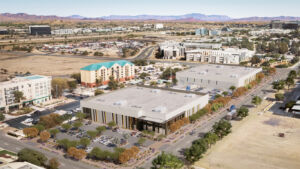On nearly every construction job site, there is a large, thick, well-worn book of detailed drawings. These design plans are the instruction book for the project. They are complicated, they are hard to carry around a busy job site and they are on their way out if augmented reality technology can reach its potential.
“Construction is complicated and construction documents aren’t intuitive,” said Eric Cylwik, virtual construction engineer senior for Sundt Construction. “Augmented reality takes the complexity of construction and makes it as natural as looking around a project.”
In the past, when faced with a problem with a construction element, project managers would have to consult the plan documents, often back in the control trailer. With augmented reality, that project manager can put on a headset, look around the problem area and see exactly what the plans call for.
Contemporary planners, engineers, designers and architects use some sort of Building Information Modeling (BIM) software in their work to create the plans for whatever projects they are designing. That BIM information produces detailed, 3-D plans for the structure. Those BIM plans are then uploaded into the augmented reality software and when a worker puts on the AR glasses or uses a tablet with a camera, they can see the plans come to life before their eyes.
“Augmented reality shows the design intent within the context of what currently is,” said Cylwik. “AR accomplishes this by layering new information over what you see, whether a 3-D model or other data.”

For example, someone can look around an unfinished building and the AR technology will highlight where vital electrical conduit or water pipes or ventilation ducts will go. A user can look around an empty space and see where walls will be framed in and where plumbing lines will be connected.
Another example is in a multi-story building that has steel reinforced concrete floors. When workers need to drill through the floor to run mechanical lines, they need to be precise. Using AR would allow them to see exactly where the holes in the floor would go and they can mark those spots.
“Instead of critical information about components and locations being spread across a series of printed documents, augmented reality shows a user exactly what they need to know when they need to know it,” Cylwik added. “A simple question like ‘how many light switches and outlets should be in this room?’ versus ‘is there a plumbing cleanout in this wall?’ will lead one to many different parts of the construction documents. In augmented reality, one just needs to look around the room.”
Virtual reality is also used in conjunction with the BIM software. Virtual reality is different in that the headwear fully covers the eyes and computer-generated images are all the person can see. A user can load the BIM plans for a building into a virtual reality program and throw on the VR glasses and see what the building will look like.

The client can walk through their space before it even begins,” said David Mettler, manager of construction technology for Renaissance Companies. “We then use a 360-degree camera on our hard hats that takes pictures as you walk the site and compiles them into a 3-D image that clients can virtually walk through as the project progresses. This is very helpful for clients who are out of town and some are located all over the world.”
Augmented reality utilizes headwear that has transparent lenses and the computer images are projected onto the lens to create a mix of real and computer generated images in the users field of vision. If the worker is using a tablet with a camera, they can pan the camera around the room and the AR software will project the building plans onto the screen.
“We can use this technology right now using tablets,” said Scott Root, managing director of The Kapture Group in Tempe. “But that doesn’t allow you to use your hands so it has its limitations.”
On-site limitations are what is holding up the AR revolution in construction. Both Root and Cylwik cited hardware issues as a major factor in limiting AR usage on a wide scale. Currently, the Microsoft HoloLens is the leading AR hardware component. However, it is known to be fragile and it is difficult to wear a safety helmet with a HoloLens, so that limits its use. Also, Cylwik said that the HoloLens tends to fail when exposed to the sun in heat above 105-degrees, something that is common on construction sites in Arizona.
“The hardware fails to consistently deliver in the extreme environment of construction,” Cylwik said.
Another factor working against AR usage is workflow and personnel acceptance. Root points out that construction professionals have their traditional workflow patterns and anytime a new technology is introduced, it causes that flow to be stymied while the workforce learns how the new technology works.
“You are trying to get the same productivity or better productivity from your people, and that’s really hard to do in the average construction job with all of the variables,” Root said. “It’s coming, though, and I think it’s going to happen really soon.”



